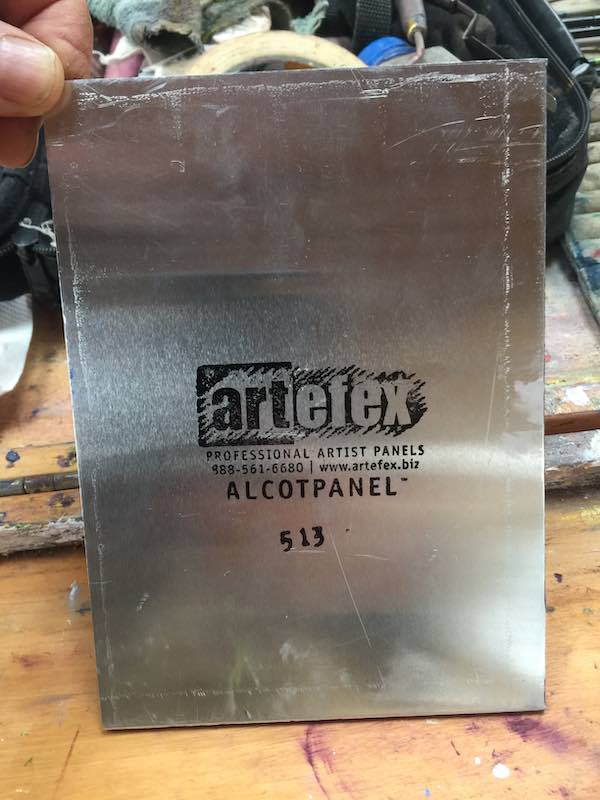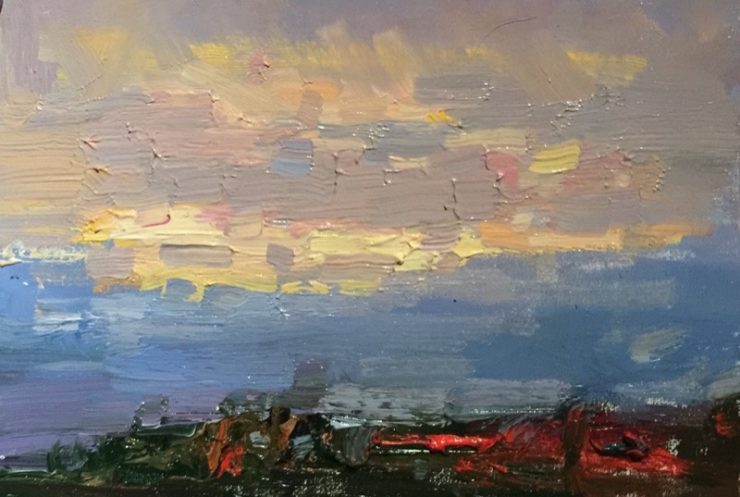(Get free painting tips and plein air painting techniques sent straight to your inbox or on my social media.)
I recently tried aluminum painting panels for a small oil painting sketches and quite liked it. I did some research on these panels and they seem quite promising and to offer advantages over many other painting supports from the archival point of view.
I recommend you take a serious look at these if you are a professional selling your work.

An Introduction To Painting On Aluminum Panels
A more recent type of painting support as an alternative to traditional canvas or linen are aluminum painting panels. These are thin panels of aluminum that have been prepared specially to receive paint. Aluminum art panels are quite rigid and relatively lightweight painting surfaces.
Two Approaches To Using Aluminum Painting Panels
There are basically two ways of using aluminum painting panels:
- Paint directly on the surface, after it has been primed.
- Paint on traditional linen or cotton that has been glued to the aluminum panel
The Benefits Of Painting On Aluminum Panels
Painting on an aluminum panel has many key advantages. The first two of these makes it an idea choice if cost is not a key issue.
Pros
- stable with changes in humidity or temperature
Aluminum painting panels react very little to changes in humidity and temperature. This is in contrast to traditional wood panels and canvas which both expand and contract with a change of temperature or humidity and so damage the painting surface. This is the single most important feature of aluminum painting supports that makes them more archival than other painting supports. This means you can store them in damp studios where traditional painting surfaces would warp. - robust
Unlike MDF and HDF (medium/high density fiberboard), aluminium painting panels will not easily damage if they are dropped. - does not release gases
Unlike medium and high density fiberboards that have been treated with formaldehyde, aluminum painting panels will not release gases over time. See https://pubs.acs.org/doi/abs/10.1021/acs.est.5b02217 - exposed areas won’t tarnish
You can leave areas on aluminum painting panels exposed, and the material will not tarnish due to its resistance to oxidation. - lightweight
Aluminum panels are quite lightweight and so ideal for large artworks which need to be transported. However for plein air painting, they are heavier then gatorboard panels to which linen has been glued.
Cons:
- expense
Aluminum panels are more expensive than panels made from MDF and HDF (medium/high density fiberboard).
How To Prepare An Aluminum Painting Panel
You can buy these panels already ready to paint on from an art supply store. In that case the panel has either a primer coat or has linen/canvas glued to it and you do not have to do anything. Just go ahead and paint on that surface.
But if you have just bought the aluminum panel and it is not already prepared for painting on, follow these steps:
- The first step is a very light scuff sanding to increase the adhesion of the primer. Use a fine grit sandpaper (at least 320). It is easier to wet-sand the panel to avoid getting dust everywhere, so use special we-sand paper. It is faster, the paper doesn’t clog up, and there is no dust.
Caution: Do not sand all the way through the polyester coating, something that is easy to do. This is a bad thing. Just lightly rough up the surface (it should be just a little more matt than it was when it was new, but it will still feel smooth) but do not expose the aluminum. - Once the sanding is done and the panel is clean (try not to touch it with your hands) make sure it is dry
- 3M, the company that manufactures the panels (3M) recommends a thin coat of DTM primer before you prime it with an oil ground. This DTM primer is formulated to bond to the polyester coating on the panel and provide a surface that will take the oil primer better. A one gallon can cost around $120 but it should prime a lot of panels. One light coat is enough.
- Apply primer coats to panels
Tip: finish with light brush strokes in random directions so there are no distracting vertical or horizontal marks that might show through in the final painting. When you use a linen, or canvas support, the texture of the material hides the brush strokes of the primer coats, but all these marks are visible on these very smooth aluminum panels. A good primer is Rublev Lead Oil Ground (from Natural Pigments in California). I like an oil primed surface to paint on because it has just the right amount of absorbency and takes the paint beautifully.
Caution: The primer has lead in it so take obvious precautions such as wearing gloves to avoid absorbing lead through your skin, and not eating it! Apply two thin coats straight out of the can and let the primer dry completely between the coats.
Thank You
Thank you for taking the time to read this article. I hope you find it useful. If you would like to get free painting tips by email, please sign up for my free tips newsletter.
If you are interested in a structured approach for learning how to paint, take a look at my online painting classes.
Happy painting!
Barry John Raybould
Virtual Art Academy











I’m trying to find info on how to hang these panels. My gallery will need them to be ready to hang. Will I need to frame every piece? I’m having trouble finding good info on simple hanging options.
The best way is to glue an aluminum hanger plate to the back of the panel. If the painting is large, then glue an aluminium back frame because it will be stronger. Google ‘aluminum back frame’ for details.
Barry
Teally interesting and informative, thanks for sharing Barry.
Thank you – that was a really interesting helpful read. I have seen these but actually didn’t know what they were for – there was no description and I can’t remember the price (euros anyway). Have just moved from France to Scotland and everything still in boxes but I shall consider this next year. I assume ghey come in various sizes?
Interesting, although I beg to differ regarding the effect of temperature. Aluminimum will not warp with humidity or heat, but its coefficient of expansion being higher than that of wood might it not end up stretching and compressing the paint under varying temperature conditions (e.g. a sunny outdoor spot) leading to stress and cracks in the paint in the long term?
Yes you are quite right Nancy. The thermal coefficient of metal is about ten times (?) that of wood I think. Although this thermal coefficient differs greatly depending on the direction of the grain. The confusion probably lies in the fact that humidity also changes with temperature so that there are in fact two variables at work simultaneously. Expansion due to humidity though is much greater than that due to temperature whatever the thermal coefficient, so that is why aluminum is a much better substrate than wood and causes less paint damage. I will do more research on this and update the article with what I find.
I got the answer from an expert in the field on this (George O’Hanlon). Here is the data on the coefficient of expansion of aluminum painting panels. The key is the difference in expansion between the oil paint and the substrate. Apparently the linseed oil expands more than the aluminium painting panel. The mathematics of it are in this article: https://paintingbestpractices.com/which-expands-more-with-temperature-paint-or-metal/
Thank you for teaching me about aluminum panels. I had no idea!
did you gesso the panel first?
the panel I used had a cotton or linen canvas already glued to it. But yes, you would need to prepare the aluminum surface first. I’ve added a section on priming it to the article.